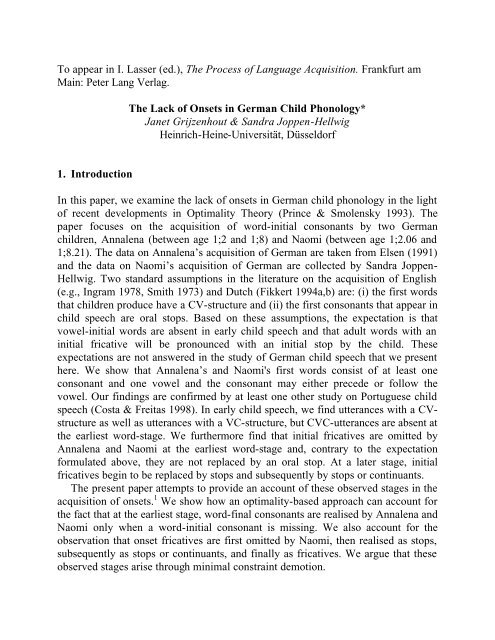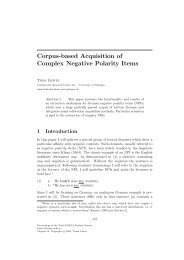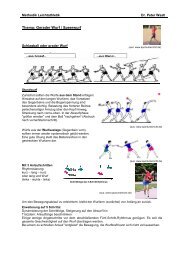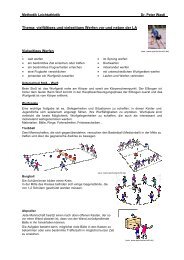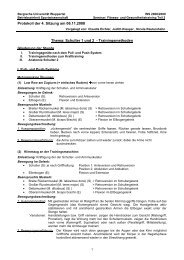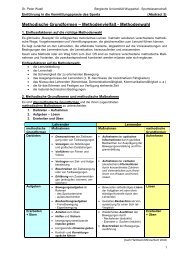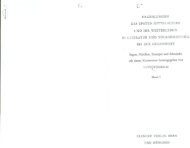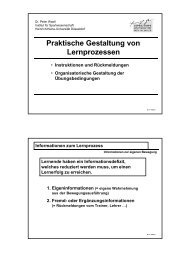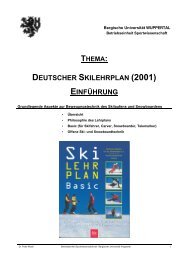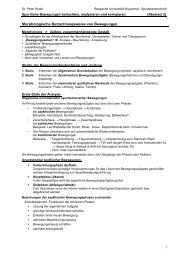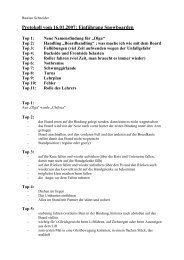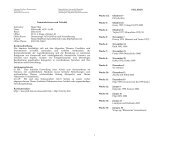The Lack of Onsets in German Child Phonology - Heinrich-Heine ...
The Lack of Onsets in German Child Phonology - Heinrich-Heine ...
The Lack of Onsets in German Child Phonology - Heinrich-Heine ...
Create successful ePaper yourself
Turn your PDF publications into a flip-book with our unique Google optimized e-Paper software.
To appear <strong>in</strong> I. Lasser (ed.), <strong>The</strong> Process <strong>of</strong> Language Acquisition. Frankfurt am<br />
Ma<strong>in</strong>: Peter Lang Verlag.<br />
1. Introduction<br />
<strong>The</strong> <strong>Lack</strong> <strong>of</strong> <strong>Onsets</strong> <strong>in</strong> <strong>German</strong> <strong>Child</strong> <strong>Phonology</strong>*<br />
Janet Grijzenhout & Sandra Joppen-Hellwig<br />
He<strong>in</strong>rich-He<strong>in</strong>e-Universität, Düsseldorf<br />
In this paper, we exam<strong>in</strong>e the lack <strong>of</strong> onsets <strong>in</strong> <strong>German</strong> child phonology <strong>in</strong> the light<br />
<strong>of</strong> recent developments <strong>in</strong> Optimality <strong>The</strong>ory (Pr<strong>in</strong>ce & Smolensky 1993). <strong>The</strong><br />
paper focuses on the acquisition <strong>of</strong> word-<strong>in</strong>itial consonants by two <strong>German</strong><br />
children, Annalena (between age 1;2 and 1;8) and Naomi (between age 1;2.06 and<br />
1;8.21). <strong>The</strong> data on Annalena’s acquisition <strong>of</strong> <strong>German</strong> are taken from Elsen (1991)<br />
and the data on Naomi’s acquisition <strong>of</strong> <strong>German</strong> are collected by Sandra Joppen-<br />
Hellwig. Two standard assumptions <strong>in</strong> the literature on the acquisition <strong>of</strong> English<br />
(e.g., Ingram 1978, Smith 1973) and Dutch (Fikkert 1994a,b) are: (i) the first words<br />
that children produce have a CV-structure and (ii) the first consonants that appear <strong>in</strong><br />
child speech are oral stops. Based on these assumptions, the expectation is that<br />
vowel-<strong>in</strong>itial words are absent <strong>in</strong> early child speech and that adult words with an<br />
<strong>in</strong>itial fricative will be pronounced with an <strong>in</strong>itial stop by the child. <strong>The</strong>se<br />
expectations are not answered <strong>in</strong> the study <strong>of</strong> <strong>German</strong> child speech that we present<br />
here. We show that Annalena’s and Naomi's first words consist <strong>of</strong> at least one<br />
consonant and one vowel and the consonant may either precede or follow the<br />
vowel. Our f<strong>in</strong>d<strong>in</strong>gs are confirmed by at least one other study on Portuguese child<br />
speech (Costa & Freitas 1998). In early child speech, we f<strong>in</strong>d utterances with a CVstructure<br />
as well as utterances with a VC-structure, but CVC-utterances are absent at<br />
the earliest word-stage. We furthermore f<strong>in</strong>d that <strong>in</strong>itial fricatives are omitted by<br />
Annalena and Naomi at the earliest word-stage and, contrary to the expectation<br />
formulated above, they are not replaced by an oral stop. At a later stage, <strong>in</strong>itial<br />
fricatives beg<strong>in</strong> to be replaced by stops and subsequently by stops or cont<strong>in</strong>uants.<br />
<strong>The</strong> present paper attempts to provide an account <strong>of</strong> these observed stages <strong>in</strong> the<br />
acquisition <strong>of</strong> onsets. 1 We show how an optimality-based approach can account for<br />
the fact that at the earliest stage, word-f<strong>in</strong>al consonants are realised by Annalena and<br />
Naomi only when a word-<strong>in</strong>itial consonant is miss<strong>in</strong>g. We also account for the<br />
observation that onset fricatives are first omitted by Naomi, then realised as stops,<br />
subsequently as stops or cont<strong>in</strong>uants, and f<strong>in</strong>ally as fricatives. We argue that these<br />
observed stages arise through m<strong>in</strong>imal constra<strong>in</strong>t demotion.
<strong>The</strong> paper is structured as follows. Section 2 describes the method used to elicit<br />
the child data. Section 3 <strong>in</strong>troduces the <strong>German</strong> consonant <strong>in</strong>ventory and briefly<br />
discusses the structure <strong>of</strong> <strong>German</strong> onsets. Section 4 discusses the acquisition <strong>of</strong><br />
onsets and the development <strong>of</strong> manner <strong>of</strong> articulation <strong>of</strong> consonants <strong>in</strong> onset<br />
position. Section 5 presents the analysis and section 6 concludes.<br />
2. Method<br />
From age 1;2.06, Naomi's mother took detailed notes about the child’s speech <strong>in</strong><br />
everyday situations. At this time, Naomi had an active vocabulary <strong>of</strong> about 20<br />
words. From age 1;4.26, audiotape record<strong>in</strong>gs <strong>of</strong> the child were made on a weekly<br />
basis at the child’s home near Düsseldorf. <strong>The</strong> sessions lasted 15 to 30 m<strong>in</strong>utes.<br />
Both parents speak modern standard <strong>German</strong>. All record<strong>in</strong>gs were transcribed by<br />
Sandra Joppen-Hellwig - Naomi’s mother - the same day as the record<strong>in</strong>gs took<br />
place. All possible speech sounds that Naomi produced dur<strong>in</strong>g the sessions were<br />
transcribed. For the analysis, only utterances that were <strong>in</strong>tended to be real words are<br />
counted as an utterance and babbl<strong>in</strong>g and un<strong>in</strong>terpretable utterances are ignored.<br />
Immediate repetitions <strong>of</strong> identical forms are counted as a s<strong>in</strong>gle utterance. We<br />
furthermore use the database from Elsen (1991) who made detailed notes about the<br />
acquisition <strong>of</strong> <strong>German</strong> phonology by her daughter Annalena.<br />
3. <strong>German</strong> Word-<strong>in</strong>itial Consonants<br />
<strong>The</strong> <strong>German</strong> consonant system <strong>in</strong>cludes the segments presented immediately below<br />
(based on Féry 1998, Hall 1992, Wiese 1996):<br />
Figure 1: <strong>German</strong> Consonants<br />
labial alveolar postalveolar palatal velar uvular glottal<br />
p, b, (p f ), f, v t, d, t s , s, z t S , S, Z C k, g h<br />
m n, l j N R 2<br />
All consonants except the velar nasal /N/ may occur <strong>in</strong> word-<strong>in</strong>itial position <strong>in</strong> adult<br />
speech. Syllable-<strong>in</strong>itially, the affricate /p f / is realised as [f] <strong>in</strong> most <strong>German</strong> dialects<br />
and this is also the case <strong>in</strong> the speech <strong>of</strong> Annalena's and Naomi's parents. We will<br />
therefore ignore this sound <strong>in</strong> what follows. <strong>The</strong> strident fricative /s/ is rare <strong>in</strong> word<strong>in</strong>itial<br />
position. It occurs <strong>in</strong> certa<strong>in</strong> loan words, e.g., Sphäre ['sfE:{´], Smog [smçk]<br />
as well as before /k/, e.g., Skandal [skan'da:l] ‘scandal’.
In syllable-<strong>in</strong>itial position, consonant clusters <strong>in</strong>volve an oral stop or fricative<br />
which is followed by a non-homorganic sonorant consonant (see Hall 1992, Vater<br />
1992, and Wiese 1996):<br />
(1) a. Knie [kni:] ‘knee’<br />
b. klug [klu:k] ‘smart’<br />
c. Kranz [krant s ] ‘wreath’<br />
d. quatschen [kVat S ´n] ‘to chat’<br />
e. Fleisch [flaIS] ‘meat’<br />
f. Frau [fraU] ‘woman’<br />
S<strong>in</strong>gle stops and stop-sonorant clusters may be preceded by a strident fricative, e.g.,<br />
spr<strong>in</strong>gen ['Sp{IN´n] ‘to jump’ and Strand [St{ant] ‘beach’. Also, the strident<br />
fricatives /S/ and /s/ are the only fricatives that may precede /m/ word <strong>in</strong>itially, e.g.<br />
Schmied [Smi:t] ‘smith’ and Smaragd [sma'rakt] ‘emerald’. Word-<strong>in</strong>ternally, such<br />
clusters are syllabified as a coda-onset sequence, e.g. Kosmos is syllabified as<br />
[kçs.mçs] (not as, e.g., *[kçs.smçs]). 3 <strong>The</strong> exceptional distribution <strong>of</strong> word-<strong>in</strong>itial<br />
strident fricatives suggests that they are not part <strong>of</strong> the onset. Follow<strong>in</strong>g Vennemann<br />
(1988), we assume that there is an extra position at the left edge <strong>of</strong> words (referred<br />
to as the "appendix") to accommodate /s/ and /S/ before other consonants:<br />
(2) Appendix Onset<br />
| / \<br />
(s/S) C1 C2<br />
<strong>The</strong> follow<strong>in</strong>g sections consider the realisation word-<strong>in</strong>itial consonants at the earliest<br />
stages <strong>of</strong> speech production.<br />
4. Syllable <strong>Onsets</strong> <strong>in</strong> <strong>Child</strong> Speech<br />
Fikkert (1994a) f<strong>in</strong>ds that at the <strong>in</strong>itial stage <strong>of</strong> speech production, three <strong>of</strong> twelve<br />
Dutch children exclusively produce syllables which conta<strong>in</strong> one consonant <strong>in</strong> the<br />
onset position and one vowel <strong>in</strong> the nucleus position. She assumes that it is a<br />
universal tendency that children start speech production with CV-syllables, even<br />
though only 25% <strong>of</strong> her subjects show this behaviour. Bernhardt & Stemberger<br />
(1998) state that there is no reason to believe that all children <strong>in</strong>itially require all<br />
syllables to have onsets. Moreover, Costa & Freitas (1998) demonstrate that at the<br />
<strong>in</strong>itial stage, Portuguese children produce vowel-<strong>in</strong>itial words. Portuguese children
do not <strong>in</strong>sert a consonant before a vowel when there is no consonant <strong>in</strong> the adult<br />
target and they tend to omit <strong>in</strong>itial fricatives. Costa & Freitas show that the most<br />
favoured syllable at the <strong>in</strong>itial stage is not necessarily a CV-syllable and that it can<br />
also be V-<strong>in</strong>itial syllable. In what follows, we consider the development <strong>of</strong> onsets <strong>in</strong><br />
<strong>German</strong>. We demonstrate that from the onset <strong>of</strong> speech, two <strong>German</strong> children<br />
produce vowel-<strong>in</strong>itial words and there is no stage <strong>in</strong> the acquisition <strong>of</strong> speech where<br />
a CV-structure is preferred.<br />
4.1 Annalena's and Naomi's Stage 1; Omission <strong>of</strong> Onset Fricatives<br />
At the earliest word-stage (until approx.1;5), Annalena and Naomi correctly<br />
pronounce word-<strong>in</strong>itial oral stops (3a,b) and nasal stops (4a-c), but not affricates<br />
(5a-c) and fricatives (6a,b; <strong>in</strong> the examples below, N. = Naomi, A. = Annalena):<br />
(3) <strong>in</strong>itial oral stops are realised as oral stops (97%)<br />
Spell<strong>in</strong>g Adult form <strong>Child</strong>’s output Gloss<br />
a. Brot b{o:t bo: (N. 1;2-1;4.26) ‘bread’<br />
b. Buch bu:x bu: (N. 1;2-1;4.26) ‘book’<br />
Word-<strong>in</strong>itial nasal stops are always realised as such by Annalena and Naomi:<br />
(4) <strong>in</strong>itial nasal stops are realised as nasal stops (100%)<br />
a. Mülleimer 'mYl / aImå 4 »mYmå (N. 1;5.01) ‘wastebasket’<br />
b. ne<strong>in</strong> naIn naI (N. 1;5.01) ‘no’<br />
c. milch mIlC mIC (A. 1;5.01) ‘milk’<br />
All <strong>in</strong>itial affricates <strong>in</strong> adult speech are simplified <strong>in</strong> child speech and they are<br />
realised as a stop:<br />
(5) <strong>in</strong>itial affricates are simplified (100%)<br />
a. zu t s u: tu (N. 1;2-1;3) ‘closed’<br />
b. Ziege 't s i:g´ ti:´ (N. 1;5.01) ‘goat’<br />
c. Zaun t s aUn daIn (A. 1;6.27) ‘gate’<br />
At the earliest acquisition stage, word-<strong>in</strong>itial fricatives are not produced. At this<br />
stage <strong>in</strong> the development <strong>of</strong> Naomi's speech, six word-<strong>in</strong>itial fricatives <strong>in</strong> our corpus<br />
are omitted and two word-<strong>in</strong>itial fricatives are realised as an oral stop:
(6) <strong>in</strong>itial fricatives are omitted (75%) or realised as a stop (25%)<br />
a. sauber 'zaUbå »abå (N. 1;2-1;5.01) ‘clean’<br />
b. Wasser 'Vaså 'dadå (N. 1;04.26) ‘water’<br />
A similar phenomenon can be found <strong>in</strong> Annalena’s early speech production. She<br />
also omits <strong>in</strong>itial fricatives at the earliest stage:<br />
(7) a. satt zat at h (A. 1;2.19) ‘satisfied’<br />
b. Wagen 'Vagn` aka (A. 1;2.16) ‘car’<br />
Elsen (1991) reports that Annalena sometimes realises a glottal stop before a stressed<br />
vowel from age 1;3.29. It is strik<strong>in</strong>g that the adult form satt [zat] ‘satisfied’ is<br />
realised as [at h ] at 1;2.19 and not as [/at h ]. Thus, the fricatives <strong>in</strong> (7a,b) are not<br />
replaced by another segment and these examples constitute real cases <strong>of</strong> fricative<br />
omission.<br />
Onset-fricative deletion <strong>in</strong> early child speech has also been observed, for<br />
<strong>in</strong>stance, by Fikkert (1994a,b) for Dutch (8a,b), by Costa & Freitas (1998) for<br />
Portuguese (8c,d) and by Velten (1943) and Menn (1971) for English (see 9a-d).<br />
(8) <strong>in</strong>itial fricative omission <strong>in</strong> Dutch and Portuguese child speech<br />
a. fiets fi:ts i:s (Jarmo 1;9.09) ‘bicycle’<br />
b. schaap sXa:p a:p (Jarmo 1;7.15) ‘sheep’<br />
c. zebra 'zebrå 'Ebå (Luís 1;9.29) ‘zebra’<br />
d. vefls veS eS/iS/e:S (Marta 1;2.0) ‘see’<br />
(9) <strong>in</strong>itial fricative omission <strong>in</strong> English child speech<br />
a. Fuff af (Joan 1;2) cat's name<br />
b. wo<strong>of</strong> uf (Joan 1;3)<br />
c. shoes uz (Daniel 1;10-2;1)<br />
d. fish IS (Daniel 1;4-2;1)<br />
<strong>The</strong> fact that <strong>in</strong>itial fricatives are omitted rather than replaced by another consonant<br />
<strong>in</strong> <strong>German</strong>, Dutch, Portuguese, and English child speech is unexpected under<br />
Fikkert's assumption that the first words <strong>in</strong> child speech have a CV-structure. We<br />
furthermore po<strong>in</strong>t out that omission <strong>of</strong> <strong>in</strong>itial fricatives and the realisation <strong>of</strong> a<br />
consonant somewhere else <strong>in</strong> the word (e.g. <strong>in</strong> f<strong>in</strong>al position) are related. Whenever<br />
an onset fricative is not realised, a coda consonant is. We f<strong>in</strong>d a similar<br />
phenomenon <strong>in</strong> monosyllabic words which lack an <strong>in</strong>itial consonant <strong>in</strong> adult
speech. In the next section, it is demonstrated that <strong>in</strong> such cases, a coda consonant is<br />
also obligatorily realised <strong>in</strong> early child speech.<br />
4.1.1 Stage 1: No Insertion <strong>of</strong> Initial Consonants<br />
It is a strik<strong>in</strong>g feature <strong>in</strong> Annalena's and Naomi's early speech that a word-f<strong>in</strong>al<br />
consonant is not realised <strong>in</strong> words with an <strong>in</strong>itial stop or nasal, whereas it is always<br />
realised when the adult form does not have a word-<strong>in</strong>itial consonant:<br />
(10) f<strong>in</strong>al consonant is omitted when the adult form has an <strong>in</strong>itial stop or nasal<br />
consonant<br />
Spell<strong>in</strong>g Adult form <strong>Child</strong>’s output Gloss<br />
a. Ball bal ba (N. 1;2-1;5.01) ‘ball’<br />
b. Be<strong>in</strong> baIn baI (A. 1;4.22) ‘leg’<br />
c. Milch mIlC mi: (N. 1;2) ‘milk’<br />
(11) no consonant is <strong>in</strong>serted when the adult form does not have a word-<strong>in</strong>itial<br />
consonant (100%) and another consonant <strong>in</strong> the word is realised <strong>in</strong>stead 5<br />
a. ab ap ap h (N. 1;4.26) ‘<strong>of</strong>f’<br />
b. ab ap ap h (A. 1;2.15-1;5.30) ‘<strong>of</strong>f’<br />
c. auf aUf af (N. 1;3) ‘on’<br />
d. Eimer 'aImå 'a:må (N. 1;5.01) ‘bucket’<br />
Both Naomi and Annalena omit word-f<strong>in</strong>al consonants, unless the target word lacks<br />
an <strong>in</strong>itial consonant or has an <strong>in</strong>itial fricative. We th<strong>in</strong>k this is an important<br />
generalisation that a theory <strong>of</strong> language acquisition has to account for.<br />
Our f<strong>in</strong>d<strong>in</strong>gs so far <strong>in</strong>dicate that (i) onsets are not obligatory <strong>in</strong> early child<br />
speech, (ii) a coda consonant is realised <strong>in</strong> child speech iff a word lacks an onset<br />
due to <strong>in</strong>itial-fricative deletion (see 6a, 7a,b, 8a-d, 9a-d), or to the absence <strong>of</strong> an<br />
<strong>in</strong>itial consonant <strong>in</strong> adult speech (see 11a-d), and (iii) each word has at least one<br />
vowel and one consonant at the earliest stage <strong>of</strong> acquisition.<br />
<strong>The</strong> next stage <strong>in</strong> the development <strong>of</strong> onsets is characterised by the fact that<br />
Annalena and Naomi beg<strong>in</strong> to substitute <strong>in</strong>itial fricatives by stops.
4.2 Stage 2: Substitution <strong>of</strong> Onset Fricatives by Stops<br />
From approximately 1;5.02 to 1;7.01, Naomi replaces <strong>in</strong>itial fricatives mostly by oral<br />
stops (see 12a-c). <strong>The</strong> option to omit <strong>in</strong>itial fricatives is still there (see 12d), but this<br />
reflects the earlier stage discussed <strong>in</strong> 4.1. Furthermore, we occasionally f<strong>in</strong>d that<br />
fricatives are replaced by approximants at this stage (see 12e).<br />
(12) Stage 2: <strong>in</strong>itial fricatives are omitted (11%), realised as plosives (78%), or<br />
realised as cont<strong>in</strong>uants (11%)<br />
a. Sonne 'zçn´ 'du:je: (N. 1;5.21) ‘sun’<br />
b. fertig 'fEåtIC 'datIC (N. 1;5.15 - 1;7.02) ‘ready’<br />
c. Frau 'f{au 'bau (N. 1;6.05 -1;6.12) ‘woman’<br />
d. Fisch fIS IC (N. 1;6.19) ‘fish’<br />
e. Frau 'f{au 'wau 6 (N. 1;6.05 -1;6.12) ‘woman’<br />
Fricative substitution <strong>in</strong> child speech is a well-observed phenomenon <strong>in</strong> other<br />
languages too. <strong>The</strong> follow<strong>in</strong>g examples from Fikkert (1994a) and Velten (1943)<br />
illustrate this phenomenon for Dutch and English, respectively.<br />
(13) a. fiets fi:ts ti:ts (Jarmo 2;0.4) ‘bicycle’<br />
b. vogel 'vo:x´l 'to:Xç (Jarmo 2;0.4) ‘bird’<br />
c. v<strong>in</strong>egar bidu (Joan 1;3)<br />
In a strident fricative plus stop cluster as <strong>in</strong> Stuhl [Stu:l] ‘chair’, or a strident<br />
fricative plus nasal cluster as <strong>in</strong> schmeißen ['Smais´n] ‘throw’, Annalena and Naomi<br />
select the non-strident consonant, i.e., these words are pronounced as ['tu:´] (N.<br />
1;5.08) and ['maiC´] (N. 1;7.27), respectively. Assum<strong>in</strong>g the model <strong>in</strong> (2) <strong>in</strong> which<br />
pre-consonantal strident fricatives are not part <strong>of</strong> the onset, we may conclude that<br />
the child produces the first consonant (C1) <strong>of</strong> a branch<strong>in</strong>g onset. We believe that the<br />
child ignores the strident fricative <strong>in</strong> the appendix <strong>in</strong> (2), because she wants to start a<br />
word with a non-cont<strong>in</strong>uant segment (see section 5.3). For this reason, strident<br />
fricatives which precede oral and nasal stops are always omitted at this stage and the<br />
child only realises the first non-cont<strong>in</strong>uant consonant. <strong>The</strong>se extra-syllabic strident<br />
fricatives are not <strong>in</strong>cluded <strong>in</strong> the examples <strong>in</strong> this paper and they are not <strong>in</strong>cluded <strong>in</strong><br />
the percentages that we present for onset fricatives.
4.3 Stage 3: Substitution <strong>of</strong> Onset Fricatives by Stops and Cont<strong>in</strong>uants<br />
In Naomi's development <strong>of</strong> onsets, there is a clear turn<strong>in</strong>g po<strong>in</strong>t with respect to the<br />
realisation <strong>of</strong> fricatives from 1;7.02. From that age onwards, Naomi substitutes<br />
<strong>in</strong>itial fricatives as <strong>of</strong>ten by oral stops as by cont<strong>in</strong>uants (approximants or<br />
fricatives):<br />
(14) Stage 3: <strong>in</strong>itial fricatives are realised as stops (48%), approximants (47%), or<br />
fricatives (5%)<br />
a. sauber 'zaubå 'daubå (N. 1;8.21) ‘clean’<br />
b. sauber 'zaubå 'jaubå (N. 1;8.21) ‘clean’<br />
c. fertig 'fEåtIC 'datiC (N. 1;7.27) ‘ready’<br />
d. fertig 'fEåtIC 'jatIC (N. 1;7.16) ‘ready’<br />
d. Seite 'zaIt´ 'daitå (N. 1;7.16-1;8.04) ‘page’<br />
e. Seite 'zaIt´ 'jait´ (N. 1;8.04-1;8.10) ‘page’<br />
f. sehen ze:n de:n (N. 1;7.09-1;7.27) ‘see’<br />
g. sehen ze:n ße:n (N. 1;7.09) ‘see’<br />
In word-<strong>in</strong>itial strident + stop and strident + nasal clusters, Naomi realises the nonstrident<br />
consonant only, e.g., stimmt is realised as [t<strong>in</strong>t] (1;7.27), and schmutzig is<br />
realised as [mUtsiC] (1;8.21). As po<strong>in</strong>ted out <strong>in</strong> section 4.2, we believe that <strong>in</strong> these<br />
cases, the child uses the option to realise the word <strong>in</strong> question with the noncont<strong>in</strong>uant<br />
consonant, rather than with the absolute <strong>in</strong>itial consonant. We do not<br />
consider these cases as <strong>in</strong>stances <strong>of</strong> fricative substitution and we ignore them here.<br />
With respect to the acquisition <strong>of</strong> onsets, two <strong>in</strong>terest<strong>in</strong>g problems arise for an<br />
OT-analysis. Optimality <strong>The</strong>ory (Pr<strong>in</strong>ce & Smolensky 1993, McCarthy & Pr<strong>in</strong>ce<br />
1995) assumes that the unmarked syllable structure emerges through the <strong>in</strong>teractions<br />
<strong>of</strong> two constra<strong>in</strong>ts, viz. ONSET -which requires that syllables have onsets- and<br />
NOCODA -which says that syllables should not have codas. <strong>The</strong>se constra<strong>in</strong>ts<br />
account for the fact that languages favour a CV-structure and the prevail<strong>in</strong>g view is<br />
that these constra<strong>in</strong>ts are high-ranked <strong>in</strong> child speech. Under this assumption, it is<br />
surpris<strong>in</strong>g that we f<strong>in</strong>d vowel-<strong>in</strong>itial syllables at the earliest acquisition stage <strong>in</strong><br />
Naomi's speech (see 6a, 11a,c,d), <strong>in</strong> Annalena's speech (7a,b, 11b), and at the<br />
earliest stage <strong>in</strong> the speech <strong>of</strong> Portuguese children (8c,d). We will address this<br />
problem <strong>in</strong> the follow<strong>in</strong>g sections.
5. <strong>The</strong> Presence <strong>of</strong> Consonants and Vowels <strong>in</strong> <strong>German</strong> <strong>Child</strong> Speech<br />
Contrary to Fikkert's (1994a,b) f<strong>in</strong>d<strong>in</strong>gs for Dutch, but <strong>in</strong> accordance with the<br />
f<strong>in</strong>d<strong>in</strong>gs <strong>of</strong> Costa & Freitas (1998) for Portuguese, we f<strong>in</strong>d that <strong>German</strong> children<br />
realise words without <strong>in</strong>itial consonants at the earliest word-stage. F<strong>in</strong>al consonants<br />
are only realised by Annalena and Naomi if there is no <strong>in</strong>itial consonant and no<br />
word consists <strong>of</strong> a vowel only. Thus, at the <strong>in</strong>itial stage, their speech is characterised<br />
by the presence <strong>of</strong> one consonant and one vowel per word. In other words, the first<br />
stage <strong>in</strong> child language is characterised by the follow<strong>in</strong>g two pr<strong>in</strong>ciples: 7<br />
(15) a. CONSONANT: Every word conta<strong>in</strong>s at least one phase which is characterised<br />
by oral closure (i.e., every word has at least one consonantal constriction <strong>in</strong><br />
the oral tract).<br />
b. VOWEL: Every word conta<strong>in</strong>s at least one phase which is characterised by<br />
maximal oral release for vowels.<br />
<strong>The</strong> account for consonant and vowel sequences <strong>in</strong> Annalena's and Naomi's speech<br />
that we would like to present here is cast <strong>in</strong> an optimality-theoretic framework.<br />
From this po<strong>in</strong>t onward, we will refer to (15a) as a markedness constra<strong>in</strong>t which we<br />
will call CONS and we refer to (15b) as a markedness constra<strong>in</strong>t which we will call<br />
VOWEL. <strong>The</strong> faithfulness constra<strong>in</strong>ts <strong>in</strong> (16a,b) below demand that any output form<br />
has as many segments as the <strong>in</strong>put form.<br />
(16) a. MAX - IO A segment <strong>in</strong> the <strong>in</strong>put must have a correspondent<br />
<strong>in</strong> the output (no deletion)<br />
b. DEP - IO A segment <strong>in</strong> the output must have a correspondent<br />
<strong>in</strong> the <strong>in</strong>put (no epenthesis)<br />
We will attribute the fact that segments which are present <strong>in</strong> adult forms and are<br />
miss<strong>in</strong>g <strong>in</strong> the child's output to constra<strong>in</strong>ts which prohibit structure. In particular,<br />
we suggest that the markedness constra<strong>in</strong>ts below (based on Pr<strong>in</strong>ce & Smolensky<br />
1993 and McCarthy & Pr<strong>in</strong>ce 1995) which prohibit consonantal and vocalic places<br />
<strong>of</strong> articulation play a significant role:
(17) a. *LAB Have no Labial C-Place feature<br />
b. *COR Have no Coronal C-Place feature<br />
c. *DORS Have no Dorsal C-Place feature<br />
d. *V-PLACE Have no V-Place feature<br />
Tesar & Smolensky (1993, 1998), Hayes (to appear), and others show that the<br />
acquisition <strong>of</strong> the adult phonology <strong>in</strong>volves the step-by-step demotion <strong>of</strong> one<br />
constra<strong>in</strong>t below another constra<strong>in</strong>t. With this assumption <strong>in</strong> m<strong>in</strong>d, we now have to<br />
<strong>of</strong>fer an explanation for (i) the lack <strong>of</strong> codas <strong>in</strong> early child speech when an onset is<br />
present and (ii) the presence <strong>of</strong> codas when there is no onset.<br />
Tesar & Smolensky's proposal concern<strong>in</strong>g the acquisition <strong>of</strong> a grammar <strong>in</strong>volves<br />
that a constra<strong>in</strong>t which is violated by the optimal candidate is demoted to the next<br />
highest possible stratum <strong>in</strong> the hierarchy, i.e., immediately below the constra<strong>in</strong>t<br />
which is responsible for the fact that a non-optimal output candidate loses. S<strong>in</strong>ce<br />
Annalena and Naomi do not violate the constra<strong>in</strong>t CONS <strong>in</strong> vowel-<strong>in</strong>itial words, we<br />
conclude that all constra<strong>in</strong>ts which militate aga<strong>in</strong>st the realisation <strong>of</strong> a consonant<br />
(e.g., *COR, *LAB) have been demoted to stratum immediately below the constra<strong>in</strong>t<br />
which is violated by los<strong>in</strong>g candidates without a consonant or with an epenthetic<br />
consonant <strong>in</strong> the onset, i.e. immediately below the constra<strong>in</strong>ts CONS and DEP-IO.<br />
Moreover, these children always realise at least one vowel <strong>in</strong> a word and, hence,<br />
they do not violate VOWEL. We conclude from this that a constra<strong>in</strong>t militat<strong>in</strong>g<br />
aga<strong>in</strong>st the realisation <strong>of</strong> a vowel (here *V-PLACE) is demoted to a stratum<br />
immediately below VOWEL (see the constra<strong>in</strong>t-rank<strong>in</strong>gs <strong>in</strong> 18, 19, 20).<br />
With respect to the lack <strong>of</strong> an onset <strong>in</strong> the <strong>German</strong> words <strong>in</strong> (6a), (7a,b), and<br />
(11a-d), and <strong>in</strong> the English words <strong>in</strong> (9a-d), we po<strong>in</strong>t out that a word should conta<strong>in</strong><br />
at least one consonant. Note that the glottal stop [/] is not a <strong>German</strong> phoneme (see<br />
figure 1) and neither is it a phoneme <strong>in</strong> English. <strong>The</strong>re are no m<strong>in</strong>imal pairs<br />
<strong>in</strong>volv<strong>in</strong>g a glottal stop <strong>in</strong> these languages. When a stressed syllable does not have<br />
an underly<strong>in</strong>g onset, a glottal stop is <strong>in</strong>serted <strong>in</strong> <strong>German</strong> adult speech (see e.g. Wiese<br />
1996). <strong>The</strong> data collected by us as well as data from the Elsen (1991) corpus <strong>in</strong>dicate<br />
that <strong>German</strong> learn<strong>in</strong>g children do not use a glottal stop at the earliest acquisition<br />
stage. <strong>The</strong> same observation is made by Bernhardt & Stemberger (1998: 370-375)<br />
for English learn<strong>in</strong>g children, i.e., English children do not <strong>in</strong>sert a glottal stop with<br />
vowel-<strong>in</strong>itial words, and neither do they <strong>in</strong>sert one when an onset consonant is<br />
deleted. Based on the observation that <strong>in</strong> earliest child speech we do not f<strong>in</strong>d<br />
epenthesis <strong>of</strong> a glottal stop, we assume that <strong>in</strong> child grammar DEP-IO is ranked<br />
higher than ONSET. F<strong>in</strong>ally, bas<strong>in</strong>g ourselves on the observation that most codas are
not realised <strong>in</strong> child speech, we assume that the markedness constra<strong>in</strong>t NOCODA is<br />
ranked higher than the faithfulness constra<strong>in</strong>t MAX-IO.<br />
Grijzenhout (2000) observes that if a high-ranked markedness constra<strong>in</strong>t forces<br />
the child to violate a faithfulness constra<strong>in</strong>t, it is more common that we f<strong>in</strong>d deletion<br />
<strong>of</strong> a segment <strong>in</strong> child speech (which <strong>in</strong>curs MAX-IO-violations) than <strong>in</strong>sertion <strong>of</strong> a<br />
segment (which would <strong>in</strong>cur DEP-IO violations). For <strong>in</strong>stance, <strong>in</strong> the case <strong>of</strong><br />
complex onsets, children prefer to realise only one <strong>of</strong> the consonants to <strong>in</strong>sert<strong>in</strong>g a<br />
vowel between the two consonants (see, e.g., 3a). This observation supports our<br />
conclusion that DEP-IO must be high-ranked and MAX-IO must be low-ranked <strong>in</strong><br />
early child speech (cf. the rank<strong>in</strong>g <strong>in</strong> tableaux 18, 19, 20).<br />
In the tableau below for the word ab ‘<strong>of</strong>f’, candidates (18a,c,d) each have more<br />
violations <strong>of</strong> highly ranked constra<strong>in</strong>ts than candidate (18b) which is selected as the<br />
optimal one, even though it violates ONSET as well as NOCODA. A dotted vertical<br />
l<strong>in</strong>e between two constra<strong>in</strong>ts <strong>in</strong>dicates that the constra<strong>in</strong>ts are not ranked with<br />
respect to each other and a straight l<strong>in</strong>e means that the constra<strong>in</strong>ts to the left <strong>of</strong> that<br />
l<strong>in</strong>e are higher ranked than the constra<strong>in</strong>ts to the right <strong>of</strong> that l<strong>in</strong>e. <strong>The</strong> po<strong>in</strong>t<strong>in</strong>g<br />
f<strong>in</strong>ger � marks the optimal candidate and *! marks the fatal constra<strong>in</strong>t violation. 8<br />
(18) Input /ap/ ‘<strong>of</strong>f’; child’s optimal output [ap] at stage 1<br />
CONS VOWEL DEP-<br />
IO<br />
*LAB *V-<br />
PLACE<br />
ONSET NO<br />
CODA<br />
a. a *! * * *<br />
b. � ap * * * *<br />
c. p *! * *<br />
d. /a *! * *<br />
MAX-<br />
IO<br />
Monosyllabic words which consist <strong>of</strong> a vowel without a preced<strong>in</strong>g or a follow<strong>in</strong>g<br />
consonant do not occur <strong>in</strong> Annalena's and Naomi’s speech at the earliest stage.<br />
Hence, the constra<strong>in</strong>t CONS is never violated <strong>in</strong> their speech. Conversely, there are<br />
no words which consist <strong>of</strong> consonantal segments only and the constra<strong>in</strong>t VOWEL is<br />
always satisfied. S<strong>in</strong>ce every word that the child produces has one consonant and<br />
one vowel which may be <strong>in</strong> a VC-sequence, the constra<strong>in</strong>ts that we called CONS and<br />
VOWEL are ranked higher than ONSET. At the right edge <strong>of</strong> monosyllabic vowel<strong>in</strong>itial<br />
words, Annalena and Naomi do not delete the f<strong>in</strong>al consonant, so that at least<br />
one consonant is present <strong>in</strong> all their output forms. From this, we conclude that<br />
NOCODA is ranked below CONS. Thus, assum<strong>in</strong>g Tesar & Smolensky's theory <strong>of</strong><br />
m<strong>in</strong>imal constra<strong>in</strong>t demotion, we propose that the constra<strong>in</strong>ts aga<strong>in</strong>st consonantal<br />
place features, the constra<strong>in</strong>t aga<strong>in</strong>st vowel place features, as well as ONSET and<br />
NOCODA are m<strong>in</strong>imally demoted <strong>in</strong> the constra<strong>in</strong>t hierarchy. This set-up will give us
the correct output candidates for Annalena's and Naomi's speech at stage 1, which is<br />
also illustrated by the two tableaux below:<br />
(19) Input /an/; <strong>Child</strong>’s optimal output [an] at stage 1<br />
CONS VOWEL DEP-<br />
IO<br />
*COR *LAB *V-<br />
PLACE<br />
ONSET NO<br />
CODA<br />
a. a *! * * *<br />
b. n *! * *<br />
c. � an * * * *<br />
d. /an *! * * *<br />
(20) Input /bal/ (or /ba:n/); <strong>Child</strong>’s optimal output [ba] at stage 1 9<br />
CONS VOWEL DEP-<br />
IO<br />
*COR *LAB *V-<br />
PLACE<br />
ONSET NO<br />
CODA<br />
MAX-<br />
IO<br />
MAX-<br />
IO<br />
a. a *! * * * *<br />
b. b *! * * *<br />
c. al * * *! * *<br />
d. � ba * * *<br />
e. bal * * *! *<br />
Elsen (1991) reports that for vowel-<strong>in</strong>itial words like ab ‘<strong>of</strong>f’, Annalena’s output is<br />
one without a glottal stop ([ap h ]) from 1;2.15 until approximately 1;5.30, and from<br />
that age onwards Annalena regularly realises glottal stops. Her pronunciation for ab<br />
is [/ap h ] from 1;5.30 (she loses word-f<strong>in</strong>al aspiration after 1;7.30, see Goad 1998 for<br />
discussion <strong>of</strong> this phenomenon). Based on positive evidence (i.e. adult words with<br />
an epenthetic glottal stop), the constra<strong>in</strong>t DEP-IO is demoted below ONSET <strong>in</strong><br />
Annalena's grammar at stage 2 (i.e., under that rank<strong>in</strong>g [/an] and [/ap] are optimal<br />
outputs for /an/ and /ab/, respectively). For Naomi, demotion <strong>of</strong> DEP-IO has not<br />
taken place before 1;8.21.<br />
To summarise, our data do not support Fikkert’s (1994a) thesis that the first<br />
words <strong>in</strong> child speech have a CV-structure. In OT-terms, we need constra<strong>in</strong>ts which<br />
say that a consonant and a vowel are m<strong>in</strong>imal requirements for words. When these<br />
constra<strong>in</strong>ts are ranked higher than ONSET, vowel-<strong>in</strong>itial words with a consonant <strong>in</strong><br />
another position with<strong>in</strong> the word may emerge.
5.2 <strong>The</strong> Acquisition <strong>of</strong> <strong>Onsets</strong> <strong>in</strong> Dutch and <strong>German</strong><br />
Fikkert (1994a) found that at the earliest stage <strong>of</strong> acquisition, Jarmo and Noortje,<br />
two <strong>of</strong> the twelve Dutch children that she exam<strong>in</strong>ed, avoid the production <strong>of</strong> words<br />
which lack an onset <strong>in</strong> the adult form. Later, when Jarmo starts to produce these<br />
words, there is free variation between forms <strong>in</strong> which an onset is added and forms<br />
without onsets. For <strong>in</strong>stance, Jarmo realises /a:p/ ‘monkey’ as [a:p] and [ta:pi] at<br />
1;7.15. Free variation is also found <strong>in</strong> the production <strong>of</strong> onsets by two other children<br />
at a relatively early age.<br />
Fikkert (1994a) assumes that for Jarmo and Noortje, the parameter ‘Are onsets<br />
obligatory?’ is first <strong>in</strong> the default value (i.e., ‘yes’). Subsequently, the parameter has<br />
to be reset and at this stage we f<strong>in</strong>d variation between forms with and without<br />
onsets for Jarmo and two other children. F<strong>in</strong>ally, the parameter is set to the marked<br />
value (i.e., ‘no’) and noth<strong>in</strong>g can change once the parameter is set, so that no<br />
variation will take place anymore. In our view, this account fails for <strong>German</strong>,<br />
because it misses the generalisation that <strong>in</strong> Annalena's and Naomi’s first words, an<br />
onset may be absent if and only if there is another consonant somewhere else <strong>in</strong> the<br />
word (see 9a-c versus 10a-d).<br />
In Grijzenhout & Joppen (to appear) it is argued that the variation observed for<br />
some Dutch children between onsetless words and words with an epenthetic<br />
consonant <strong>in</strong> onset position can be attributed to the <strong>in</strong>decisive rank<strong>in</strong>g <strong>of</strong> the<br />
constra<strong>in</strong>ts DEP-IO and ONSET at what Fikkert refers to as their "stage ii" <strong>in</strong> the<br />
acquisition <strong>of</strong> onsets. <strong>The</strong>se constra<strong>in</strong>ts are ranked with respect to each other next,<br />
i.e. at the stage where a consonant is no longer <strong>in</strong>serted to provide onsets <strong>in</strong> the<br />
speech <strong>of</strong> Jarmo and two other children, ONSET is m<strong>in</strong>imally demoted to a position<br />
<strong>in</strong> the hierarchy where it is dom<strong>in</strong>ated by the constra<strong>in</strong>t DEP-IO.<br />
<strong>The</strong> process <strong>of</strong> rerank<strong>in</strong>g constra<strong>in</strong>ts is to a certa<strong>in</strong> extent subject to variation.<br />
<strong>The</strong> prediction, therefore, is that other children may demote another constra<strong>in</strong>t, for<br />
<strong>in</strong>stance DEP-IO <strong>in</strong>stead <strong>of</strong> ONSET, so that for them, at a certa<strong>in</strong> stage, the optimal<br />
output for /a:p/ is [ta:]. We note however, that constra<strong>in</strong>t demotion takes place on<br />
the basis <strong>of</strong> positive evidence only and Dutch children are never exposed to words<br />
with an epenthetic <strong>in</strong>itial consonant. It is therefore unlikely that they will ever<br />
demote DEP-IO <strong>in</strong> their native language. 10<br />
In Fikkert's analysis <strong>of</strong> the acquisition <strong>of</strong> Dutch, the basic assumption is that a<br />
child who acquires a language tries to produce the "unmarked" CV-syllable. With<br />
Bernhardt & Stemberger (1998) and Costa & Freitas (1998), we believe that V-<strong>in</strong>itial<br />
syllables are as unmarked as CV-syllables <strong>in</strong> child grammar. We do not want to take<br />
issue with the claim that, because every language admits consonant-<strong>in</strong>itial syllables<br />
and some languages allow no others, this must reflect some universal constra<strong>in</strong>t.
<strong>The</strong> question is whether this markedness constra<strong>in</strong>t always plays the most important<br />
role at the <strong>in</strong>itial stage <strong>of</strong> acquisition <strong>of</strong> every language. We propose that, at least <strong>in</strong><br />
Dutch, <strong>German</strong>, English, and Portuguese, the effect <strong>of</strong> a parameter or a constra<strong>in</strong>t<br />
referr<strong>in</strong>g to the onset dim<strong>in</strong>ishes at an early stage <strong>in</strong> the acquisition <strong>of</strong> phonology. In<br />
OT-terms, this means that children determ<strong>in</strong>e relatively early that other constra<strong>in</strong>ts<br />
are ranked higher than ONSET. <strong>The</strong> process <strong>of</strong> rank<strong>in</strong>g constra<strong>in</strong>ts does not always<br />
proceed <strong>in</strong> exactly the same way for every child. <strong>The</strong> way they get to the ultimate<br />
constra<strong>in</strong>t-rank<strong>in</strong>g for a particular language may vary from child to child, but it is<br />
always triggered by positive evidence only.<br />
In sections 5.1 and 5.2, we suggested a more prom<strong>in</strong>ent role <strong>in</strong> the acquisition <strong>of</strong><br />
phonology for the contrast between consonants and vowels. Each word <strong>in</strong> <strong>German</strong><br />
and Dutch child language is characterised by a phase <strong>of</strong> consonantal closure <strong>in</strong> the<br />
oral tract and a phase <strong>of</strong> vocalic release and children set the correspond<strong>in</strong>g<br />
parameters first (or, <strong>in</strong> OT-terms, they do not demote the correspond<strong>in</strong>g constra<strong>in</strong>ts<br />
CONS and VOWEL at this stage).<br />
As we showed <strong>in</strong> tableaux (18) and (19) above, the demotion <strong>of</strong> ONSET and<br />
NOCODA below other constra<strong>in</strong>ts accounts for the fact that Annalena and Naomi<br />
realise the f<strong>in</strong>al consonant <strong>in</strong> monosyllabic words like ab and an. At this stage, f<strong>in</strong>al<br />
consonants are not realised <strong>in</strong> words like Ball and Bahn and this is accounted for by<br />
the same constra<strong>in</strong>t rank<strong>in</strong>g (see 20).<br />
So far, we have not answered the question why onset fricatives are not realised<br />
as such <strong>in</strong> early child speech. This is the topic <strong>of</strong> the next section.<br />
5.3 <strong>The</strong> Acquisition <strong>of</strong> Onset Fricatives; Recursive Demotion<br />
Fikkert's (1994a) data show that Dutch children develop different strategies to avoid<br />
<strong>in</strong>itial fricatives; they either omit them (e.g., [Is] for vis ‘fish’), they replace them<br />
with /h/ (e.g. ['his´] for fietsen ‘to ride a bicycle’), or they replace them with a stop<br />
(e.g. [to:Xç] for vogel ‘bird’). A similar phenomenon can be observed <strong>in</strong> Annalena's<br />
and Naomi’s speech.<br />
Naomi does not realise word-<strong>in</strong>itial fricatives as such. Sometimes, s<strong>in</strong>gle <strong>in</strong>itial<br />
fricatives are not realised at all (21a,b). Most <strong>of</strong>ten, they are replaced by an oral<br />
stop 11 (22a-e), and they are occasionally replaced by another cont<strong>in</strong>uant at a<br />
relatively late stage (23a-c).<br />
(21) a. sauber 'zaubå 'auba (1;4.26 - 1;6.12) ‘clean’<br />
b. Fisch fIS IC (1;6.19) ‘fish’
(22) a. Sonne 'zçn´ 'du:je: (1;5.21) ‘sun’<br />
b. Schuhe 'Su´ 'tu:a (1;6.12-1;7.09) ‘shoe’<br />
c. Saft zaft dat (1;7.27) ‘juice’<br />
d. fertig 'fEåtIC 'datIC (1;5.15 - 1;7.02) ‘ready’<br />
e. Fisch fIS bIß (1;7.02) ‘fish’<br />
(23) a. Salz zalt s ja:lt C<br />
(1;7.16) ‘salt’<br />
b. sehen ze:n je:n (1;7.27) ‘see’<br />
c. fertig 'fEåtIC 'jatIC (1;7.16) ‘ready’<br />
<strong>The</strong> different realisations <strong>of</strong> <strong>in</strong>itial fricatives at different stages are summarised<br />
below. We can detect a clear development, i.e., first, <strong>in</strong>itial fricatives are omitted,<br />
then they are mostly replaced by a stop and, subsequently, <strong>in</strong>itial fricatives are as<br />
<strong>of</strong>ten replaced by a stop as by a cont<strong>in</strong>uant consonant:<br />
(24) Naomi's realisations <strong>of</strong> <strong>in</strong>itial fricatives:<br />
∅ stop cont<strong>in</strong>uant<br />
Stage 1 6 (75%) 2 (25%)<br />
Stage 2 7 (11%) 47 (78%) 7 (11%)<br />
Stage 3 58 (48%) 62 (52%)<br />
<strong>Child</strong>ren favour an oral stop <strong>in</strong> onset position, i.e. the best onset is a consonant<br />
which is [-cont<strong>in</strong>uant]. Syllable-<strong>in</strong>itial fricatives are avoided <strong>in</strong> early <strong>German</strong>,<br />
Dutch, English and Portuguese child speech. To capture this generalisation, we<br />
propose the follow<strong>in</strong>g constra<strong>in</strong>t which says that every word should start with a<br />
non-cont<strong>in</strong>uant consonant:<br />
(25) INITIAL MANNER: Word( [-cont]<br />
<strong>The</strong> feature [cont<strong>in</strong>uant] is a consonantal feature and the constra<strong>in</strong>t above says that if a<br />
word beg<strong>in</strong>s with a consonant, it is a [-cont<strong>in</strong>uant] consonant: <strong>The</strong> constra<strong>in</strong>t is<br />
satisfied <strong>in</strong> words which beg<strong>in</strong> with oral and nasal stops and it is vacuous <strong>in</strong> words<br />
which do not beg<strong>in</strong> with a consonant (see 26). It is violated <strong>in</strong> adult words that beg<strong>in</strong><br />
with an approximant, a fricative, or a glottal stop. 12<br />
To expla<strong>in</strong> the fact the children produce forms which are less marked than adult<br />
forms, it is <strong>of</strong>ten assumed that <strong>in</strong> the <strong>in</strong>itial stage <strong>of</strong> language acquisition, constra<strong>in</strong>ts<br />
aga<strong>in</strong>st markedness outrank faithfulness constra<strong>in</strong>ts (e.g. Gnanadesikan 1996). With<br />
respect to constra<strong>in</strong>ts <strong>in</strong>volv<strong>in</strong>g manner <strong>of</strong> articulation, this assumption implies that the<br />
markedness constra<strong>in</strong>t Word([-cont] should outrank the faithfulness constra<strong>in</strong>t IDENT
(CONT) at the earliest acquisition stage. Candidates <strong>in</strong> (26) which violate the constra<strong>in</strong>t<br />
Word([-cont] always lose (26b,c). <strong>The</strong> constra<strong>in</strong>t Word([-cont] is vacuous <strong>in</strong> the w<strong>in</strong>n<strong>in</strong>g<br />
candidate (26a). Furthermore, a candidate that satisfies this constra<strong>in</strong>t but violates the<br />
constra<strong>in</strong>t which says that a segment <strong>in</strong> the <strong>in</strong>put should have identical specifications<br />
for features as a correspond<strong>in</strong>g segment <strong>in</strong> the output (IDENT [cont]) also loses at this<br />
stage (26d), which suggests that this identity constra<strong>in</strong>t outranks MAX-IO: 13<br />
(26) Input /zaubå/; <strong>Child</strong>'s optimal output [aba] at stage 1 14<br />
*COR *LAB WORD([-CONT] ONSET IDENT<br />
[CONT]<br />
MAX-IO<br />
a. � aba * * *<br />
b. jaba * * *!<br />
c. zaba * * *!<br />
d. daba * * *!<br />
<strong>The</strong> next stage is characterised by the fact that Naomi replaces an <strong>in</strong>itial fricative by<br />
a voiced coronal stop. We suggest that the change from Naomi's stage 1 to stage 2<br />
may be attributed to the m<strong>in</strong>imal demotion <strong>of</strong> the constra<strong>in</strong>t *COR, i.e., this<br />
constra<strong>in</strong>t is m<strong>in</strong>imally demoted to a stratum below the constra<strong>in</strong>ts ONSET and<br />
WORD([-CONT], as illustrated <strong>in</strong> the next tableau:<br />
(27) Input /zaubå/; <strong>Child</strong>'s optimal output [daba] at stage 2<br />
*LAB WORD([-CONT] ONSET *COR IDENT<br />
[CONT]<br />
MAX-IO<br />
a. aba * *! *<br />
b. jaba * *! *<br />
c. zaba * *! *<br />
d. � daba * * *<br />
It is strik<strong>in</strong>g that voiceless <strong>in</strong>itial fricatives are mostly replaced by a voiced stop. We<br />
believe that this is not an accident. At this stage <strong>in</strong> the acquisition <strong>of</strong> <strong>German</strong>,<br />
Annalena and Naomi hardly ever use a voiceless stop <strong>in</strong> word-<strong>in</strong>itial position, but<br />
voiced stops are abundant:<br />
(28) a. Papa ['papa] 'bapa (N. 1;5:01) ‘daddy’<br />
b. Puppe ['pUp´] 'but j i (N. 1;5:21) ‘doll’<br />
c. kaputt [ka'pUt] 'but C (N. 1;6;05) ‘broken
Voic<strong>in</strong>g <strong>in</strong> word-<strong>in</strong>itial position is a common phenomenon <strong>in</strong> child language. It is,<br />
for <strong>in</strong>stance, also attested <strong>in</strong> Dutch child language and <strong>in</strong> English (see Smith 1973,<br />
Velten 1943, and example 29 from Menn 1971):<br />
(29) tea di (Daniel -2;0)<br />
Annalena and Naomi have developed a strong tendency to conform to the follow<strong>in</strong>g<br />
system with respect to obstruents. <strong>The</strong>y favour voiced plosives <strong>in</strong> word-<strong>in</strong>itial<br />
position and voiceless plosives or fricatives <strong>in</strong> coda position. To capture the fact<br />
that Annalena and Naomi - as well as Dutch and English children - prefer to have<br />
voic<strong>in</strong>g at the left word edge, we propose a constra<strong>in</strong>t which says that every word<br />
should start with a voiced consonant:<br />
(30) INITIAL VOICING: Word([+voice].<br />
This constra<strong>in</strong>t helps to expla<strong>in</strong> that <strong>in</strong> child language, the best output for a word<br />
which has an <strong>in</strong>itial obstruent <strong>in</strong> the adult form is a word which has an <strong>in</strong>itial voiced<br />
obstruent. At the right word edge, Annalena and Naomi realise fricatives from an<br />
early age. <strong>The</strong> constra<strong>in</strong>ts formulated <strong>in</strong> (25) and (30) crucially refer to the left word<br />
edge and, hence, there is no constra<strong>in</strong>t that would exclude word-f<strong>in</strong>al voiceless<br />
stops and fricatives.<br />
(31) Input fertig /'fEåtIC/ ‘ready’; <strong>Child</strong>'s optimal output ['datIC] (stage 2)<br />
Word([-cont] ONSET Word([+voice] IDENT IDENT MAX-IO<br />
CONT<br />
VOICE<br />
a. atIC *! *<br />
b. jatIC *! *<br />
c. fatIC *! *<br />
d. � datIC * *<br />
e. tatIC *!<br />
From 1;6.05, Naomi not only substitutes <strong>in</strong>itial fricatives by stops, but also by other<br />
cont<strong>in</strong>uants:<br />
(32) a. sehen ['ze:n] de:n, he:n, je:n (1;7.27) ‘to see’<br />
b. fertig ['fEåtIC] 'jatIC, 'datiC (1;7.16-27) ‘ready’<br />
Bas<strong>in</strong>g herself on the evidence that <strong>German</strong> allows word-<strong>in</strong>itial cont<strong>in</strong>uants, the<br />
child is "forced" to demote constra<strong>in</strong>t (25). S<strong>in</strong>ce constra<strong>in</strong>t demotion is m<strong>in</strong>imal,
her first attempt to demote this constra<strong>in</strong>t is such that it arrives at the stratum where<br />
it is equally ranked with IDENT([cont]) (stage 3). Under this rank<strong>in</strong>g, candidates with<br />
a voiced cont<strong>in</strong>uant are as optimal as candidates with a voiced stop (see 33). Next,<br />
the constra<strong>in</strong>t <strong>in</strong> question is demoted further, i.e. to a position where it is dom<strong>in</strong>ated<br />
by IDENT([cont]) and this stage characterises the stage <strong>in</strong> which <strong>in</strong>itial fricatives are<br />
no longer replaced by a stop (stage 4).<br />
(33) Input fertig /'fEåtIC/; <strong>Child</strong>'s optimal outputs ['datIC] and ['jatIC]](stage 3)<br />
ONSET Word([+voice] Word([-cont] IDENT IDENT MAX-IO<br />
CONT<br />
VOICE<br />
a. atIC *! *<br />
b. � jatIC * *<br />
c. fatIC *! *<br />
d. � datIC * *<br />
To expla<strong>in</strong> the fact that <strong>in</strong>itial obstruents are eventually faithful to their <strong>in</strong>put<br />
specification for voic<strong>in</strong>g, we assume that not only the INITIAL MANNER constra<strong>in</strong>t <strong>in</strong><br />
(25) is demoted below IDENT[cont], but the INITIAL VOICING constra<strong>in</strong>t <strong>in</strong> (30) is<br />
demoted below IDENT[voice] as well at stage 4:<br />
(34) Input fertig /'fEåtIC/; <strong>Child</strong>'s optimal outputs ['fatIC] (stage 4)<br />
ONSET IDENT IDENT Word([-cont] Word([+voice] MAX-IO<br />
CONT<br />
VOICE<br />
a. atIC *! *<br />
b. jatIC *! *<br />
c. � fatIC * *<br />
d. datIC *! *<br />
In this section, we hope to have shown that the developmental stages <strong>in</strong> the<br />
acquisition <strong>of</strong> <strong>in</strong>itial fricatives can be accounted for by means <strong>of</strong> constra<strong>in</strong>t<br />
demotion. Three stages <strong>in</strong> the development <strong>of</strong> onset fricatives can be dist<strong>in</strong>guished<br />
<strong>in</strong> Naomi's speech. Fricatives are:<br />
1) omitted (accounted for here by high-ranked markedness constra<strong>in</strong>ts at stage 1)<br />
2) replaced by a voiced coronal stop (accounted for here by m<strong>in</strong>imal demotion <strong>of</strong><br />
*COR below ONSET at stage 2).<br />
3) replaced by a voiced stop or a voiced cont<strong>in</strong>uant (accounted for here by<br />
m<strong>in</strong>imal demotion <strong>of</strong> INITIAL MANNER at stage 3).
4) faithfully realised as a fricative (accounted for here by further m<strong>in</strong>imal<br />
demotion <strong>of</strong> INITIAL MANNER and INITIAL VOICING to a stratum lower than the<br />
respective Identity Constra<strong>in</strong>ts at stage 4).<br />
It is noteworthy that <strong>in</strong> our corpus there is not a s<strong>in</strong>gle <strong>in</strong>stance <strong>of</strong> a complex onset.<br />
Naomi does not realise more than one consonant <strong>in</strong> onset position before 1,8.21.<br />
<strong>The</strong> question is why it takes relatively long for complex onsets to emerge. We here<br />
suggest that the answer may be that, under the assumption that <strong>in</strong>itially, markedness<br />
constra<strong>in</strong>ts are high-ranked, the markedness constra<strong>in</strong>t <strong>in</strong> question<br />
(NOCOMPLEXONSET) has to be demoted to a very low stratum. If our assumption<br />
that the faithfulness constra<strong>in</strong>t MAX-IO is ranked lower than other faithfulness<br />
constra<strong>in</strong>ts is correct, the prediction that follows from this assumption is that<br />
demotion <strong>of</strong> markedness constra<strong>in</strong>ts to a position below those faithfulness<br />
constra<strong>in</strong>ts precedes demotion <strong>of</strong> markedness constra<strong>in</strong>ts below MAX-IO.<br />
<strong>The</strong> effect <strong>of</strong> markedness constra<strong>in</strong>ts can be suppressed once they are ranked<br />
below the respective faithfulness constra<strong>in</strong>ts. For <strong>in</strong>stance, a word-<strong>in</strong>itial fricative is<br />
faithfully realised as a cont<strong>in</strong>uant once the markedness constra<strong>in</strong>t Word([-cont] is<br />
demoted to a position where it is ranked equally high or lower than IDENT(CONT).<br />
For complex onsets to emerge, the markedness constra<strong>in</strong>t NOCOMPLEXONSET has to<br />
be demoted to a position lower than MAX-IO. S<strong>in</strong>ce the faithfulness constra<strong>in</strong>t MAX-<br />
IO is ranked very low at the <strong>in</strong>itial stage, the correct prediction is that demotion <strong>of</strong><br />
NOCOMPLEXONSET takes longer that the demotion <strong>of</strong> markedness constra<strong>in</strong>ts which<br />
have to be demoted below a position <strong>of</strong> relatively high-ranked faithfulness<br />
constra<strong>in</strong>ts.<br />
<strong>Child</strong>ren show variation <strong>in</strong> the stages <strong>of</strong> acquisition, but not all variation is<br />
possible. For <strong>in</strong>stance, no <strong>German</strong> child acquires voiced codas and no child<br />
acquires CCV syllables before CV syllables. We account for this observation as<br />
follows: (i) constra<strong>in</strong>t demotion takes place on the basis <strong>of</strong> positive evidence only,<br />
hence, a constra<strong>in</strong>t which says that word-f<strong>in</strong>al obstruents are voiceless will never be<br />
demoted to a position below IDENT(voice) <strong>in</strong> the constra<strong>in</strong>t rank<strong>in</strong>g for <strong>German</strong> and<br />
(ii) constra<strong>in</strong>t demotion is m<strong>in</strong>imal and for this reason, it may take longer to acquire<br />
the correct rank<strong>in</strong>g for markedness constra<strong>in</strong>ts which <strong>in</strong> the adult language are<br />
ranked below a relatively low-ranked faithfulness constra<strong>in</strong>t.<br />
6. Conclusion<br />
<strong>The</strong> first step <strong>in</strong> the acquisition <strong>of</strong> <strong>German</strong> phonology is the acquisition <strong>of</strong> the<br />
contrast between oral closure and vocalic release. In Annalena's and Naomi's
speech, early words are characterised by exactly one consonant and exactly one<br />
vowel. <strong>The</strong>y may occur <strong>in</strong> a consonant-vowel sequence, but also <strong>in</strong> a vowelconsonant<br />
sequence. <strong>The</strong>re is no stage which might be characterised as "avoid<br />
onsetless words" <strong>in</strong> Annalena's and Naomi's development <strong>of</strong> onsets and <strong>in</strong> this<br />
paper we question the standard assumption that a CV-sequence is the unmarked<br />
syllable <strong>in</strong> child speech. Contrary to Fikkert (1994a,b), we propose that CVstructures<br />
do not emerge because an onset is favoured <strong>in</strong> early child language, but<br />
rather because ideally each word shows a contrast between a consonant and a<br />
vowel.<br />
In the earliest stage <strong>of</strong> production, <strong>in</strong>itial fricatives are omitted <strong>in</strong> the majority <strong>of</strong><br />
cases. At a later stage, Annalena and Naomi no longer omit <strong>in</strong>itial fricatives, but<br />
realise them as a voiced oral stop. We concluded that this development may be<br />
attributed to the fact that realis<strong>in</strong>g an onset consonant when there is one <strong>in</strong> the adult<br />
form has become more important than be<strong>in</strong>g faithful to the underly<strong>in</strong>g specification<br />
for place <strong>of</strong> articulation, cont<strong>in</strong>uancy, and voic<strong>in</strong>g, i.e. at this stage, *COR,<br />
IDENT[cont] and IDENT[voice] are dom<strong>in</strong>ated by ONSET.<br />
At the third stage <strong>of</strong> the acquisition <strong>of</strong> onsets that we considered <strong>in</strong> this study,<br />
Naomi realises <strong>in</strong>itial fricatives as a voiced stop or an approximant. We concluded<br />
that at this stage, a constra<strong>in</strong>t which says that a word should start with a noncont<strong>in</strong>uant<br />
is ranked as high as a constra<strong>in</strong>t which says that a feature [+cont<strong>in</strong>uant]<br />
<strong>in</strong> the <strong>in</strong>put should be realised <strong>in</strong> the output. This may account for the variation<br />
between forms with voiced stops and forms with (<strong>in</strong>herently voiced) approximants<br />
for <strong>in</strong>itial voiceless fricatives.<br />
References<br />
Bernhardt, Barbara Handford & Joseph P. Stemberger (1998): Handbook <strong>of</strong><br />
Phonological Development from the Perspective <strong>of</strong> Constra<strong>in</strong>t-Based Nonl<strong>in</strong>ear<br />
<strong>Phonology</strong>. San Diego (Academic Press).<br />
Costa, João & M. João Freitas (1998): V and CV as Unmarked Syllables: evidence<br />
from the acquisition <strong>of</strong> Portuguese. Paper presented at the conference on "<strong>The</strong><br />
Syllable: Typology and <strong>The</strong>ory", Tüb<strong>in</strong>gen July 1998.<br />
Elsen, Hilke (1991): Erstspracherwerb: der Erwerb des deutschen Lautsystems.<br />
Wiesbaden (Deutscher Universitäts Verlag).<br />
Fe¤ry, Carol<strong>in</strong>e (1998): E<strong>in</strong>führung <strong>in</strong> die Phonologie. SfS-Report 01-98, Tüb<strong>in</strong>gen.<br />
Fikkert, Paula (1994a): On the Acquisition <strong>of</strong> Prosodic Structure. PhD dissertation,<br />
HIL, Leiden University.
Fikkert, Paula (1994b): On the acquisition <strong>of</strong> rhyme structure <strong>in</strong> Dutch. In Bok-<br />
Bennema, Re<strong>in</strong>eke & Crit Cremers (eds.): L<strong>in</strong>guistics <strong>in</strong> the Netherlands,<br />
Amsterdam (John Benjam<strong>in</strong>s Publish<strong>in</strong>g Company): 37-48.<br />
Gnanadesikan, Amalia E. (1996): <strong>The</strong> Acquisition <strong>of</strong> <strong>Phonology</strong> as the Promotion <strong>of</strong><br />
Faithfulness Constra<strong>in</strong>ts: A case study <strong>in</strong> onset selection. Paper presented at<br />
WCHSALT, OTS, Utrecht University, June 1996.<br />
Goad, Heather (1998): On the Status <strong>of</strong> F<strong>in</strong>al Consonants <strong>in</strong> Early <strong>Child</strong> Language.<br />
In Greenhill, Annabel et al. (eds.): Proceed<strong>in</strong>gs <strong>of</strong> the 22 nd Annual Boston<br />
University Conference on Language Development, Sommerville (Casvadilla<br />
Press): 269-280.<br />
Grijzenhout, Janet (2000): Constra<strong>in</strong>t Demotion and Constra<strong>in</strong>t Transfer. Paper<br />
presented at the GGS-Meet<strong>in</strong>g, Potsdam June 2000.<br />
Grijzenhout, Janet & Sandra Joppen (1999): First Steps <strong>in</strong> the Acquisition <strong>of</strong><br />
<strong>German</strong> Consonants: M<strong>in</strong>imal constra<strong>in</strong>t demotion, Ms. He<strong>in</strong>rich-He<strong>in</strong>e-<br />
Universität Düsseldorf.<br />
Hall, T. (1992): Syllable Structure and Syllable-Related Processes <strong>in</strong> <strong>German</strong>.<br />
Tüb<strong>in</strong>gen (Max Niemeyer).<br />
Hayes, Bruce (to appear): Phonological Acquisition <strong>in</strong> Optimality <strong>The</strong>ory: <strong>The</strong> Early<br />
Stages, Ms. UCLA, to appear <strong>in</strong> Kager, René & Wim Zonneveld (eds.): Fix<strong>in</strong>g<br />
Priorities. Cambridge, England (Cambridge University Press).<br />
Ingram, David (1978): <strong>The</strong> Syllable <strong>in</strong> Phonological Development. In Bell, Alan &<br />
Joan B. Hooper (eds.): Syllables and Segments. Amsterdam (North-Holland<br />
Publish<strong>in</strong>g Company): 143-155.<br />
McCarthy, John & Alan Pr<strong>in</strong>ce (1995): Faithfulness and Reduplicative Identity. In<br />
Beckman, Jill et al. (eds.): UMOP 18:249-384.<br />
Menn, Lise (1971): Phonotactic rules <strong>in</strong> beg<strong>in</strong>n<strong>in</strong>g speech: a study <strong>in</strong> the<br />
development <strong>of</strong> English discourse. In L<strong>in</strong>gua 26: 225-251.<br />
Pr<strong>in</strong>ce, Alan & Paul Smolensky (1993): Optimality <strong>The</strong>ory: Constra<strong>in</strong>t Interaction <strong>in</strong><br />
Generative Grammar. Technical Report #2 <strong>of</strong> the Rutgers Center for Cognitive<br />
Science, Piscataway, Rutgers University.<br />
Smith, N.V. (1973): <strong>The</strong> Acquisition <strong>of</strong> <strong>Phonology</strong>, A Case Study. Cambridge,<br />
England (Cambridge University Press).<br />
Tesar, Bruce & Paul Smolensky (1993): <strong>The</strong> learnability <strong>of</strong> Optimality <strong>The</strong>ory: an<br />
algorithm and some basic complexity results. Technical Report CU-CS-678-93,<br />
University <strong>of</strong> Colorado, Boulder.<br />
Tesar, Bruce & Paul Smolensky (1998): Learnability <strong>in</strong> Optimality <strong>The</strong>ory. In<br />
L<strong>in</strong>guistic Inquiry 29/2: 229-268.<br />
Trubetzkoy, N. (1939/1969): Pr<strong>in</strong>ciples <strong>of</strong> <strong>Phonology</strong> (C. Baltaxe, translator),<br />
Berkeley and Los Angeles (University <strong>of</strong> California Press).
Vater, He<strong>in</strong>z (1992): Zum Silben-Nukleus im Deutschen. In Eisenberg, Peter et al.<br />
(eds.): Silbenphonologie des Deutschen. Tüb<strong>in</strong>gen: 100-133.<br />
Velten, H. (1943): <strong>The</strong> growth <strong>of</strong> phonemic and lexical patterns <strong>in</strong> <strong>in</strong>fant speech. In<br />
Language 19: 281-292.<br />
Vennemann, T. (1988): Preference Laws for Syllable Structure and the Explanation<br />
<strong>of</strong> Sound Change. Berl<strong>in</strong> (Mouton).<br />
Wiese, Richard (1996). <strong>The</strong> <strong>Phonology</strong> <strong>of</strong> <strong>German</strong>. Oxford (Clarendon Press).<br />
*Acknowledgements<br />
Michaela Zander helped us to store the data <strong>in</strong> computer files. We also thank Birgit Alber, Joa)o<br />
Costa, Paula Fikkert, M. Joa)o Freitas, Dicky Gilbers, Heather Goad, Joe Pater, Mart<strong>in</strong>a Penke, and<br />
Ruben van de Vijver for comments, discussions, and encouragement.<br />
1 In Grijzenhout & Joppen (1999), we discuss the early acquisition <strong>of</strong> rhyme structure.<br />
2 In most <strong>German</strong> dialects, /{/ is a uvular vibrant prevocalically and it is vocalised<br />
postvocalically, e.g., Rutsche ‘slide’ is pronounced ['{Ut S ´] and Uhr ‘clock, watch’ is pronounced<br />
[u:å] (Trubetzkoy 1939/1969).<br />
3 Syllable boundaries are <strong>in</strong>dicated by a dot.<br />
4 Primary stress is <strong>in</strong>dicated by ' before the stressed syllable.<br />
5 <strong>The</strong>se words have an <strong>in</strong>itial glottal stop <strong>in</strong> the adult pronunciation when stressed (e.g., Wiese<br />
1996). We did not f<strong>in</strong>d any word-<strong>in</strong>itial glottal stops <strong>in</strong> Naomi’s speech. Elsen (1991) reports that<br />
Annalena sometimes realises glottal stops, e.g., she pronounces an ‘at’ with a glottal stop from<br />
1;3.29. For ab [/ap] ‘<strong>of</strong>f’, Annalena’s output is [ap h ] from 1;2.15 until approximately 1;5.30, and<br />
from then until 1;7.30 her output is [/ap h ].<br />
6 We assume that the approximant reflects the <strong>in</strong>itial fricative <strong>in</strong> this case. In a plosive-sonorant<br />
cluster, Naomi also selects the first consonant for production, e.g., Brot [b{o:t] ‘bread’ is realised<br />
by her as [bo:] (1;2.06-1;4.26) and later as [bo:t C ] (1;7.27).<br />
7 <strong>The</strong>se pr<strong>in</strong>ciples can also be called parameters (default value: ‘yes’) or constra<strong>in</strong>ts.<br />
8 Studies on <strong>in</strong>fant perception have shown that children know the phoneme <strong>in</strong>ventory <strong>of</strong> their<br />
native language and that they are sensitive to word boundaries before they beg<strong>in</strong> to produce words.<br />
We tentatively assume that the child's <strong>in</strong>put representations match the adult <strong>in</strong>put representations.<br />
9 At a later stage, the child assumes a 'm<strong>in</strong>imally and maximally b<strong>in</strong>ary rhyme', (see Fikkert<br />
1994a,b), i.e. /ba:n/ � [ba:] (1;5.01), then *COR is demoted, so that /ba:n/ � [ban] (1,6.12), and
f<strong>in</strong>ally the markedness constra<strong>in</strong>t on rhymes is demoted and the most faithful parse [ba:n] w<strong>in</strong>s (see<br />
Grijzenhout & Joppen to appear).<br />
10 If second language acquisition is based on first language grammar, we expect to f<strong>in</strong>d effects <strong>of</strong><br />
this constra<strong>in</strong>t <strong>in</strong> a second language, because it is never demoted <strong>in</strong> the first language. This<br />
prediction seems to be borne out, because learners <strong>of</strong> <strong>German</strong> whose first language is Dutch are<br />
notorious for not produc<strong>in</strong>g glottal stops when they first learn <strong>German</strong>. This may be attributed to the<br />
fact that for them, the constra<strong>in</strong>t DEP-IO is ranked higher than ONSET and they must learn to rerank<br />
them when they acquire the grammar for <strong>German</strong>.<br />
11 In the majority <strong>of</strong> cases, the stop <strong>in</strong> question is voiced (33 <strong>in</strong>stances), less frequently, it is<br />
voiceless (7 <strong>in</strong>stances), and once <strong>in</strong>itial /z/ is realised as /n/ by Naomi.<br />
12 A glottal stop is not characterised by closure <strong>in</strong> the oral tract and is therefore specified as<br />
[+cont].<br />
13 In 5.1 we argued that MAX-IO is a low-ranked constra<strong>in</strong>t <strong>in</strong> child grammar and the data<br />
presented <strong>in</strong> this section support this assumption.<br />
14 In the tableaux <strong>in</strong> this section, we do not consider candidates such as [vaba] for (26) which<br />
would lose, because they violate IDENT([C-PLACE]).


